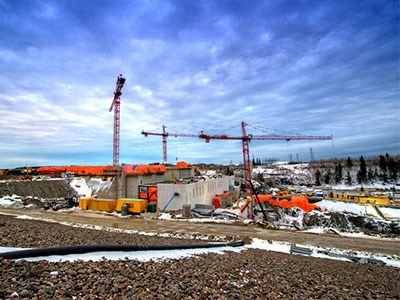The Lower Mattagami hydroelectric redevelopment project has reached a milestone, completing the 67 megawatt (MW) Little Long generating station, the first of four station upgrades in the multi-year, $2.6-billion project. After going online in mid-January, its total output is now 205 MW.
The project is a partnership between Moose Cree First Nation and Ontario Power Generation (OPG), which gives the Moose Cree a 25 per cent stake in the project. Job creation, employment and the involvement of local businesses are all additional benefits of the project.
“The Lower Mattagami project is an historic project which is the result of a solid partnership between the Moose Cree First Nation and Ontario Power Generation,” Moose Cree Chief Norm Hardisty Jr. said in a news release.
“This project has changed the economic landscape of the Moose Cree First Nation and the surrounding area. It is environmentally sustainable and has created many economic opportunities, including hundreds of jobs for our citizens, as well as other Ontarians. This project has enabled our First Nation to establish a strong economic foundation to build on in the years ahead.”
During its peak, the project employed 1,600 people, including more than 250 of First Nations and Métis descent. With the peak of construction now passed, employment has dropped off, but skills gained through construction of the project are transferrable to other areas.
Neal Kelly, the OPG’s director of media, issues and information management, said many of the province’s stations are approaching their centenaries. With regular upgrades and the application of new technologies, many can operate for decades, serving local communities as a significant economic driver for decades.
“If you think about what the Moose Cree First Nation has ahead of them, they’ll have an equity stream for decades and decades to come, so that can really benefit their community,” he said.
Many infrastructure projects around the North are on traditional First Nations land, Kelly added.
By giving communities a stake in the project, infrastructure necessary to the province gets built, while First Nations benefit through jobs, job training, and capacity building.
“We’re pretty proud of our partnership and we’re pretty proud of our Aboriginal relationship with the Moose Cree,” Kelly said.
The project is now 80 per cent complete and remains on time and on budget, Kelly said, and work continues at the other three stations simultaneously.
With most of the concrete poured—a labour-intensive part of the process—the focus is now on the design and construction of the facilities, Kelly said.
OPG anticipates another unit at Harmon generating station will be in service later this year, adding 78 MW to its capacity and bringing its total capacity to 220 MW.
The one unit being constructed at Kipling Generating Station will add 78 MW to its current capacity for a total of 232 MW.
At Smoky Falls Generating Station, the OPG is build three new generating units. The original station, which currently has a capacity of 52 MW, has been in operation since 1927.
Once complete, the new units will have a total capacity of 267 MW.
Kelly said the entire project will be completed by mid-2015.
The build has been a “massive” project—the largest hydroelectric project in Northern Ontario in 40 years, Kelly said. And it’s been a significant economic driver for Northern Ontario in the areas of employment and training for residents, capacity building with First Nations, and the awarding of contracts worth millions of dollars to local business.
The project has additionally earned a good safety record.
Across Ontario, the OPG maintains five operation centres located in Timmins, North Bay, Renfrew, Niagara Falls, and Thunder Bay, which oversee the operation of 65 hydroelectric stations.




